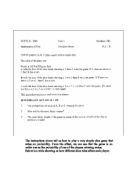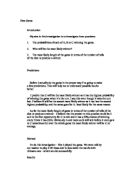The instructions above tell us how to play a very simple dice game that relies on probability. From the offset, we can see that the game is an unfair one as the probability of one of the players winning varies.
Below is a table showing us how different dice roles affect each player.
Dice
Number
2
3
4
5
6
A Wins
B Wins
C Wins
We can see that the distribution of numbers is not even. However, the probability of each player winning is conditional because if A throws a one, the game finishes and B does not get a chance to throw.
To illustrate this more clearly I have created a conditional probability tree diagram:
From this simple diagram, the following results are easily obtainable:
st Round
2nd Round
3rd Round
4th Round
A
1/6
5/108
25/1944
25/34992
B
5/18
25/324
25/5832
625/104976
C
5/18
25/324
25/5832
625/104976
The most important thing I found that each probability had in common with one another, except Player A's first term, was that all the numbers on top were divisible by five and that all the bottom numbers were divisible by 18:
25/5 = 5...324/18 = 18...625/5 = 125...104976/18 = 5832.
You will notice that when any of the probabilities are divided by 5/18 the result is the previous probability. This is because the probability of a player winning is multiplied by the probability of all the previous rounds passing. Seeing as the probability of the round passing is exactly equal to the probability of C winning in the first round, this value can only be 5/18. Therefore a player's winning probability is decreased by means of multiplication by a fraction less than one (5/18).
When I come to create a formula, this will be very useful as I now know that it must involve 5/18.
Formulae to find the probability of either A, B or C winning in the nth round.
The probabilities that I have found are those of no one winning before that round and either A, B or C winning accordingly.
These values can be used to create a formula for finding the probability of A, B or C winning in the nth round.
I will start with B and C. We can see that the probability of B winning a round is the same as C winning the round. Therefore, the formula for finding this probability should be the same.
I shall start with some experimental work to see of any relationships or patterns are apparent. From my earlier work, we can see that the fraction 5/18 is very important so I shall try and include this in my research.
st Round
2nd Round
3rd Round
4th Round
B or C Winning
5/18
25/324
25/5832
625/104976
(25/324)/(5/18)= 5/18
(25/324) = (5/18) x (5/18)
(25/324) = (5/18)2
(5/18)2 = P(B winning in the 2nd Round)
(125/5832)/(5/18) = 25/324
(125/5832)/(5/18) = (5/18)2
(125/5832) = (5/18) x (5/18)2
(125/5832) = (5/18)3
Below is a table showing us how different dice roles affect each player.
Dice
Number
2
3
4
5
6
A Wins
B Wins
C Wins
We can see that the distribution of numbers is not even. However, the probability of each player winning is conditional because if A throws a one, the game finishes and B does not get a chance to throw.
To illustrate this more clearly I have created a conditional probability tree diagram:
From this simple diagram, the following results are easily obtainable:
st Round
2nd Round
3rd Round
4th Round
A
1/6
5/108
25/1944
25/34992
B
5/18
25/324
25/5832
625/104976
C
5/18
25/324
25/5832
625/104976
The most important thing I found that each probability had in common with one another, except Player A's first term, was that all the numbers on top were divisible by five and that all the bottom numbers were divisible by 18:
25/5 = 5...324/18 = 18...625/5 = 125...104976/18 = 5832.
You will notice that when any of the probabilities are divided by 5/18 the result is the previous probability. This is because the probability of a player winning is multiplied by the probability of all the previous rounds passing. Seeing as the probability of the round passing is exactly equal to the probability of C winning in the first round, this value can only be 5/18. Therefore a player's winning probability is decreased by means of multiplication by a fraction less than one (5/18).
When I come to create a formula, this will be very useful as I now know that it must involve 5/18.
Formulae to find the probability of either A, B or C winning in the nth round.
The probabilities that I have found are those of no one winning before that round and either A, B or C winning accordingly.
These values can be used to create a formula for finding the probability of A, B or C winning in the nth round.
I will start with B and C. We can see that the probability of B winning a round is the same as C winning the round. Therefore, the formula for finding this probability should be the same.
I shall start with some experimental work to see of any relationships or patterns are apparent. From my earlier work, we can see that the fraction 5/18 is very important so I shall try and include this in my research.
st Round
2nd Round
3rd Round
4th Round
B or C Winning
5/18
25/324
25/5832
625/104976
(25/324)/(5/18)= 5/18
(25/324) = (5/18) x (5/18)
(25/324) = (5/18)2
(5/18)2 = P(B winning in the 2nd Round)
(125/5832)/(5/18) = 25/324
(125/5832)/(5/18) = (5/18)2
(125/5832) = (5/18) x (5/18)2
(125/5832) = (5/18)3






